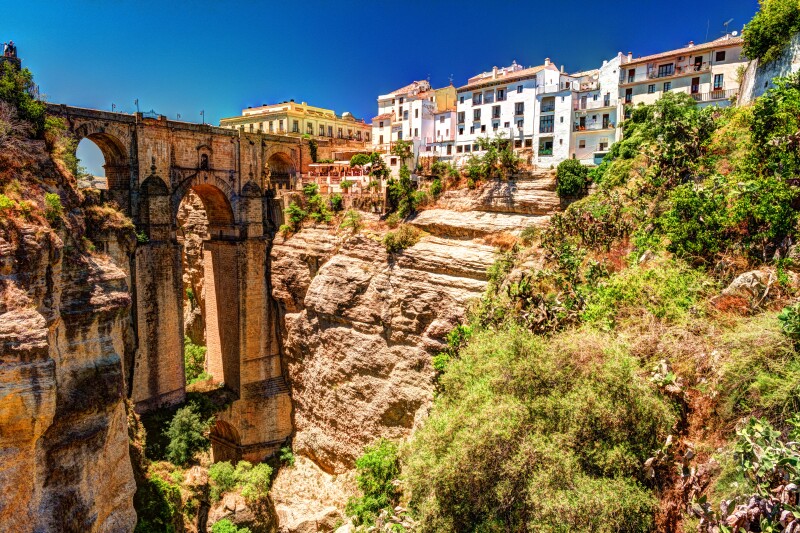If you’re looking to venture beyond bustling Spanish cities such as Barcelona and Madrid, consider exploring any number of Spain’s incredibly charming small towns. Steeped in history and unspoiled by skyscrapers, Spain’s quaint historic villages—there are nearly 20,000—even have a dedicated list that’s compiled annually by the Association of the Most Beautiful Villages in Spain, which since 2011 has grown to include almost 100 of the country’s most picture-perfect settlements. Many of these spots are accessible from Spain’s major cities by public transportation, but renting a car is the way to go when it comes to comfort and flexibility. (Just remember to get an international driver’s license before you hit the road.)
Here are some of the dreamiest hidden villages in Spain; some are recognized on the association’s list and others are lesser known.

Morella, a medieval fortress in eastern Spain, is situated on a rocky hilltop and features significant Gothic-style architecture.
Photo by Lorena Cirstea/Shutterstock
1. Morella, Castellón
- View on Google Maps
- Travel time: Two hours by car from Valencia and three hours by car from Barcelona
- Where to stay: Las Moradas Del Temple is about 16 miles away in a neighboring town but is one of the most highly rated accommodations in the area. Book now.
This ancient fortress in eastern Spain comprises a rocky outcrop topped with a towering castle and crumbling medieval walls. On an overcast day, the walled town is evocative of a villain’s lair that might be used as a filming location for Game of Thrones. Beyond its impressive hilltop position and significant Romanesque and Gothic-style architecture, Morella is noted for its artisan baked goods, such as flaons, or palm-size pastries stuffed with fresh cheese and ground almonds soaked in aguardiente (Spanish moonshine made from distilled grape liquor) and mistela, a fortified wine. The medieval town is also known for traditional textiles, namely the wool blankets that have been made locally since the 13th century and today are sold at shops around town. Oddly enough, and of particular interest to parents traveling with small children, Morella is also home to a dinosaur museum full of prehistoric fossils and other archaeological artifacts that were excavated in the area.

The white village of Frigiliana is located on Spain’s southern Costa del Sol near the Sierras of Tejeda, Almijara, and Alhama Nature Park.
Photo by KikoStock/Shutterstock
2. Frigiliana, Andalucía
- View on Google Maps
- Travel time: Less than one hour by car from Málaga and approximately one hour by car from Granada
- Where to stay: Millers of Frigiliana is a family-run, thoroughly renovated boutique property located in the heart of the town’s Moorish quarters. Book now.
With its winding labyrinth of whitewashed houses and steep cobblestone alleys decorated with hand-painted ceramic mosaics, this Mediterranean mountain village is reminiscent of a seaside town in the Greek Islands—but Frigiliana is purely Andalucían. Situated on the southern Costa del Sol, this town offers sweeping vistas of blue skies and blue waters in equal parts.
At the top of “El Fuerte” hill, which overlooks the white village, the 9th-century Moorish Castillo de Lizar is a prime spot to take in the surrounding scenery, and the Moorish old quarter known as Barribarto offers plenty of shops for local handicrafts. Every year during the last weekend in August, the tiny town celebrates its confluence of Christian, Muslim, and Jewish traditions with the Festival of Three Cultures. During three days, restaurants here create special tasting menus for the event and food stalls serve up delicacies like traditional Arabic pastries.

It’s believed that people have been living in Rupit for over 1,000 years.
Photo by Bborriss.67/Shutterstock
3. Rupit, Catalonia
- View on Google Maps
- Travel time: Less than two hours by car from Barcelona)
- Where to stay: La Rectoria De Sant Miquel De Pineda is a bed-and-breakfast sited and a former priest’s home that dates to the 12th century. Book now.
This village in Catalonia may make you wonder if you’ve inadvertently wandered onto the set of a live-action Disney film, with its cobblestone streets and stone houses adorned with wooden balconies and flowerpots. A bubbling stream splits the village in half, so you have to cross a wooden hanging bridge on foot to get to the town center, but don’t be fooled by Rupit’s near-perfection: This town has survived everything from plagues to earthquakes during its centuries of existence. For a special outing, pack a lunch of local charcuterie on bread and pick up apple cakes known as coques de l’avia (grandmother’s cakes) from any bakery in town, then take a leisurely hike (approximately two hours) to the crystalline Sallent Waterfall nearby.

San Esteban de Gormaz is home to a well-preserved Romanesque bridge and the 11th-century San Miguel Church.
Photo by Juan Enrique del Barrio/Shutterstock
4. San Esteban de Gormaz, Castile-Leon
- View on Google Maps
- Travel time: Approximately two hours by car from Madrid
- Where to stay: El Rincón de Elena is a hotel that operates out of a traditional Catalan home; guests can rent individual rooms or the entire home. Book now.
Every third weekend in August, locals from this medieval village in northwestern Spain dress up in period costumes to sell artisan wares—including candles, dried herbs, chocolate, and cheese. No matter the time of year, travelers can walk across the Duero River on the well-conserved Romanesque bridge and visit the 11th-century San Miguel Church, both highlights of San Esteban de Gormaz. As you explore, look for mysterious chimneys jutting straight out of the ground—they’re actually “breathing” vents for the town’s underground wine cellars. Nearby, the Bodegas Gormaz vineyard is worth a trip to sample area wines. While not as well-known as Spain’s Rioja wine region, Ribera del Duero is famous throughout Spain for its meaty tempranillo reds.

The Moorish village of Albarracín is home to approximately 1,000 people.
Photo by AntonioAlcon/Shutterstock
5. Albarracín, Aragon
- View on Google Maps
- Travel time: Less than four hours by car from Madrid
- Where to stay: Parador De Teruel is a half-hour drive from Albarracín and operates out of a Mudejar-style mansion. Book now.
This picturesque village is named for the Berber dynasty—the Banu Razin—that settled in this part of Spain sometime around the 9th century. Built within a rocky canyon on the hills above the Guadalaviar River, it is home to some 1,000 people. Much of the isolated mountain town was destroyed during the Spanish Civil War, but the country’s government later restored many of the village’s 11th- and 12th-century homes. Albarracín has both Moorish and Catholic influences and features narrow, cobbled streets, a Gothic cathedral, the ruins of a Moorish alcazar, and pieces of a 10th-century curtain wall. In fact, Spaniards love this ancient village so much that some voted it the most beautiful in Spain a few years ago.

In a 2018 survey from the national El País newspaper, Spaniards voted Cudillero the second-most-beautiful village in Spain.
Photo by Alfonso de Tomas/Shutterstock
6. Cudillero, Asturias
- View on Google Maps
- Travel time: Approximately three hours by car from Bilbao
- Where to stay: Casona De La Paca is a former country manor house in a meadow near the sea. Book now.
The coastal fishing village of Cudillero is known for its colorful houses and hillside location on northern Spain’s Asturian coast. This small town by the sea is where Spaniards come when they’re seeking beach time but want to escape the crowds. (In 2018, El País’s readers ranked Cudillero as the second-most-beautiful town in Spain, just behind Albarracín.) Head to Silence Beach (Playa del Silencio) for a day of lounging, then stroll the promenade around Puerto Pesquero and duck into a tavern for some fresh fish and a glass of caña. Don’t miss the dramatic coastline and cliffs at Cabo Vidio, a short drive from town.

The Ronda is most famous for its picturesque gorge, but it’s also the birthplace of modern bull fighting.
Photo by Romas_Photo/Shutterstock
7. Ronda, Andalucía
- View on Google Maps
- Travel time: Less than 90 minutes from Málaga
- Where to stay: Catalonia Reina Victoria offers scenic views of the surrounding mountains. Book now.
Ronda has some of the most dramatic sights of any Spanish town thanks to the Tajo Gorge—it clocks in at 394 feet deep—which runs straight through the middle of it—each of its sides are connected by the Puente Nuevo, or “New Bridge,” completed in 1793.
Considered the birthplace of modern bullfighting, Ronda is where matador Francisco Romero first faced off around 1726 with a muleta, a red cape hiding a sword, against a bull. It’s believed that he was the first person to ever kill a bull in the ring face to face. Visitors can check out the local bullfighting ring, Bullring of the Royal Cavalry of Ronda, designed in 1785 by Martín de Aldehuela, the same architect who built the New Bridge. These days, the ring is a riding school. However, visitors can still learn about the history of bullfighting with an on-property Bullfighting Museum—antique saddlery and ancient firearms are also on display.

Soller’s orange tram makes it easy for travelers to get from the town’s mountains to the sea.
Photo by proslgn/Shutterstock
8. Sóller, Mallorca
- View on Google Maps
- Travel time: Half an hour from Palma
- Where to stay: Hotel Finca Ca N’ai is an adults-only hotel—the property has been owned by the Mallorcan Morell family since 1723. Book now.
Sóller sits on the northeast coast of Mallorca in the “Valley of Oranges” (drinking freshly squeezed orange juice while you’re in town is practically mandatory). Though you could drive from Palma, one of the most popular ways to travel to Sóller is by a historic train line that whisks passengers by citrus orchards; some of them have been in production since the 13th century. The town’s square is also not to be missed, with its fairy-tale-like buildings from the 14th century. The nearly 300-year-old Sant Bartomeu church is the crowning jewel of the town square with its elaborate Gothic and baroque architectural influences. After exploring, set aside enough time to relax on Sóller’s white-sand beach.
See the full list of “The Most Beautiful Villages in Spain.”
This article originally appeared online in February 2017; it was most recently updated on May 3, 2023 to include current information. Mae Hamilton contributed to the reporting of this story.











